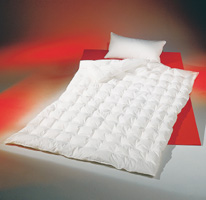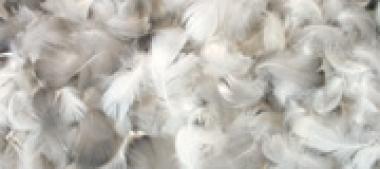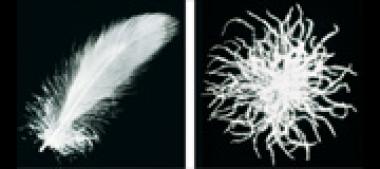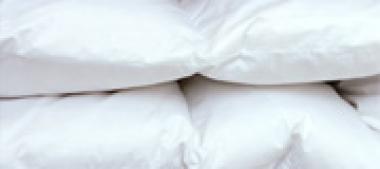What are the advantages of down- and feather-filled duvets?
- „Custom-tailored“
When buying duvets and pillows the individual needs while asleep are decisive criteria. Down-and feather-filled bedding products can be “customised”, i. e. they can be manufactured entirely according to the individual needs of the customer. There is a wide variety of duvet sizes, filling weights and stitching patterns so that the duvet can be specially tailored according to individual needs.
In this regard, the individual need for warmth and the requirements for the duvet comfort play a role (weight, drapeabililty).
For instance, a down-filled duvet for the winter with interior baffle walls is ideal for people who feel cold easily at night or want to sleep at low temperatures in a bedroom with an open window. Stitched-through, light down duvets are recommended for use in summer.
Down offer ideal sleeping comfort. They are lightweight and assure excellent climate regulation. A pleasant warmth quickly spreads during the sleep and the absorbed perspiration is being eliminated.
- low weight
Waterfowl feathers (goose and duck) have high fill power values, which means the capacity to trap large quantities of air (bulking power). The filling power of down is even better.
Down-filled duvets contain down imbedding large quantities of air pockets which act as an insulating layer. The percentage of air reduces the weight of the duvet in proportion to its volume. Hence feather- and in particular down-filled duvets keep the body warm and comfortable during the sleep and are very light at the same time.
- Excellent thermal insulation capacity
The insulating effect of a duvet crucially depends on
- the filling material (for instance down and feathers)
The grade of thermal insulation may differ depending on the filling quality and the proportion of down and feathers. The higher the down percentage the better the fill power values and thus the thermal insulation capacity of the duvet.
For this reason, many consumers prefer in particular duvets filled with a blend of 90 % down and 10 % feathers.
Feather and down blends are mainly used for pillows, since feathers help to support the head resting on the pillow, but more and more people now prefer a pillow with a soft down filling.
- the weight of the filling (indicated in grams)
The weight of a filling (indicated in grams) may differ depending on the individual requirements. Depending on the filling weight, the duvets are manufactured for use in summer or in winter. Duvets are available in a wide variety of stitching patterns and constructions to meet the customers´ very special requirements.
The filling of a single size summer duvet weighs about 200 grams, and the filling of a very warm single size duvet with interior baffle walls with various compartments weighs approximately 800 - 1000 grams (size 135 x 200 cm).
- the stitching construction (for instance with or without interior baffle walls).
Basically, the construction of a duvet is determined by the stitching pattern. Duvets are available in a wide variety, the traditional bag duvet or ballon duvet without any stitching, a duvet with various compartments and interior baffle walls. Summer duvets contain cold zones which have been created on purpose, winter duvets are supposed to have a high insulating factor.
 Example of a special stitching. Source: Brinkhaus, Warendorf.
Example of a special stitching. Source: Brinkhaus, Warendorf.
- bulking capacity, that is to say the capacity of the filling to trap air. The air-filled pockets make out the insulating properties of the duvet (fill power). Down provide the best fill power values.
- drapeability
The term “drapeability“ describes the capacity of the duvet to adapt to the shape of the sleeper and his or her movements during the sleep. Since everybody changes the position in bed several times during the sleep, it is crucial that the duvet readily adapts to each position of the body. Channels formed during the sleep admitting cold air to get into the bed might affect restful sleep and are perceived by the sleeper as being uncomfortable.
- Favourable micro climate
Down-and-feather-filled bedding duvets and pillows are very capable of absorbing and transmitting the body's humidity outside the bed even in persons with strong perspiration.
- How does the KIS®-system help to choose the ideal down duvet?
- Why do down-and feather-filled duvets provide such a favourable micro climate?
- What does the term “warmth without weight“ mean?
- What blends of down and feathers are most suitable?
- What are the most useful colours for down and feather blends for pillows?
- What does the term filling weight mean?
- Duvets sewn in diamond patterns or box squares etc. – what are the differences?
- What does the term "fill power" mean?
















